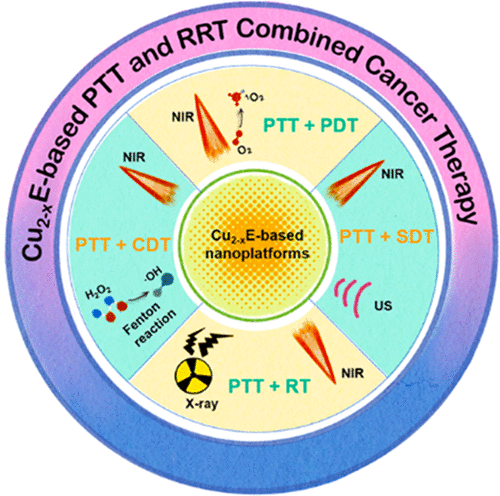当前位置:
X-MOL 学术
›
ACS Biomater. Sci. Eng.
›
论文详情
Our official English website, www.x-mol.net, welcomes your
feedback! (Note: you will need to create a separate account there.)
Recent Advances in Combination of Copper Chalcogenide-Based Photothermal and Reactive Oxygen Species-Related Therapies
ACS Biomaterials Science & Engineering ( IF 5.4 ) Pub Date : 2020-08-11 , DOI: 10.1021/acsbiomaterials.0c00830 Yi Zhao 1 , Biao-Qi Chen 1, 2 , Ranjith Kumar Kankala 1, 2 , Shi-Bin Wang 1, 2 , Ai-Zheng Chen 1, 2
ACS Biomaterials Science & Engineering ( IF 5.4 ) Pub Date : 2020-08-11 , DOI: 10.1021/acsbiomaterials.0c00830 Yi Zhao 1 , Biao-Qi Chen 1, 2 , Ranjith Kumar Kankala 1, 2 , Shi-Bin Wang 1, 2 , Ai-Zheng Chen 1, 2
Affiliation

|
In recent times, the copper chalcogenide (Cu2–xE, E = S, Se, Te, 0 ≤ x ≤ 1)-based nanomaterials have emerged as potent photothermal agents for photothermal therapy (PTT) because of their advantageous features, such as the low cost, reduced toxicity, biodegradability, and strong absorption of near-infrared (NIR) light in a relatively wide range of wavelength. Nevertheless, the applicability of Cu2–xE-based PTT is limited because of its inadequate photothermal conversion efficiency, as well as insufficient destruction of the tumor area unexposed to the NIR laser. Fortunately, Cu2–xE nanomaterials also act as photosensitizers or Fenton-reaction catalysts to produce reactive oxygen species (ROS), referring to ROS-related therapy (RRT), which could further eradicate cancer cells to address the aforementioned limitations of PTT. Moreover, PTT improves RRT based on photodynamic therapy (PDT), sonodynamic therapy (SDT), chemodynamic therapy (CDT), and radiotherapy (RT) in different ways. Inspired by these facts, integrating Cu2–xE-based PTT with RRT into a single nanoplatform seems an ideal strategy to achieve synergistically therapeutic effects for cancer treatment. Herein, we discuss the synergetic mechanisms, composition, and performances of recent nanoplatforms for the combination of Cu2–xE-based PTT and RRT. In addition, we give a brief overview on some specific strategies for the further improvement of Cu2–xE-based PTT and RRT combined cancer treatment to enable the complete eradication of cancer cells, such as realizing the imaging-guided synergistic therapy, promoting deep tumor penetration of the nanosystems, and boosting O2 or H2O2 in the tumor microenvironment. Finally, we summarize with intriguing perspectives, focusing on the future tendencies for their clinical application.
中文翻译:

硫族铜基光热与活性氧相关疗法联合应用的最新进展
近年来,基于铜硫属化物(Cu 2– x E,E = S,Se,Te,0≤x≤1)的纳米材料因其优越的特性而成为光热疗法(PTT)的有效光热剂。低成本,低毒性,可生物降解性以及在相对较宽的波长范围内对近红外(NIR)光的强吸收性。然而,由于Cu 2 – x E基PTT的光热转换效率不足,以及未暴露于NIR激光的肿瘤区域破坏不足,因此其适用性受到限制。幸运的是,Cu 2– x电子纳米材料还充当光敏剂或Fenton反应催化剂以产生活性氧(ROS),是指与ROS有关的治疗(RRT),可进一步根除癌细胞以解决上述PTT的局限性。此外,PTT以不同的方式基于光动力疗法(PDT),声动力疗法(SDT),化学动力疗法(CDT)和放射疗法(RT)改善了RRT。受这些事实的启发,将基于Cu 2 – x E的PTT与RRT集成到单个纳米平台中似乎是实现协同治疗癌症效果的理想策略。在这里,我们讨论了Cu 2– x结合的新型纳米平台的协同机制,组成和性能。基于E的PTT和RRT。此外,我们简要概述了一些进一步改善基于Cu 2 – x E的PTT和RRT联合癌症治疗以实现彻底根除癌细胞的具体策略,例如实现影像学引导的协同治疗,促进纳米系统深层的肿瘤渗透,并在肿瘤微环境中增强O 2或H 2 O 2。最后,我们以引人入胜的观点进行了总结,着眼于其临床应用的未来趋势。
更新日期:2020-09-14
中文翻译:

硫族铜基光热与活性氧相关疗法联合应用的最新进展
近年来,基于铜硫属化物(Cu 2– x E,E = S,Se,Te,0≤x≤1)的纳米材料因其优越的特性而成为光热疗法(PTT)的有效光热剂。低成本,低毒性,可生物降解性以及在相对较宽的波长范围内对近红外(NIR)光的强吸收性。然而,由于Cu 2 – x E基PTT的光热转换效率不足,以及未暴露于NIR激光的肿瘤区域破坏不足,因此其适用性受到限制。幸运的是,Cu 2– x电子纳米材料还充当光敏剂或Fenton反应催化剂以产生活性氧(ROS),是指与ROS有关的治疗(RRT),可进一步根除癌细胞以解决上述PTT的局限性。此外,PTT以不同的方式基于光动力疗法(PDT),声动力疗法(SDT),化学动力疗法(CDT)和放射疗法(RT)改善了RRT。受这些事实的启发,将基于Cu 2 – x E的PTT与RRT集成到单个纳米平台中似乎是实现协同治疗癌症效果的理想策略。在这里,我们讨论了Cu 2– x结合的新型纳米平台的协同机制,组成和性能。基于E的PTT和RRT。此外,我们简要概述了一些进一步改善基于Cu 2 – x E的PTT和RRT联合癌症治疗以实现彻底根除癌细胞的具体策略,例如实现影像学引导的协同治疗,促进纳米系统深层的肿瘤渗透,并在肿瘤微环境中增强O 2或H 2 O 2。最后,我们以引人入胜的观点进行了总结,着眼于其临床应用的未来趋势。











































 京公网安备 11010802027423号
京公网安备 11010802027423号